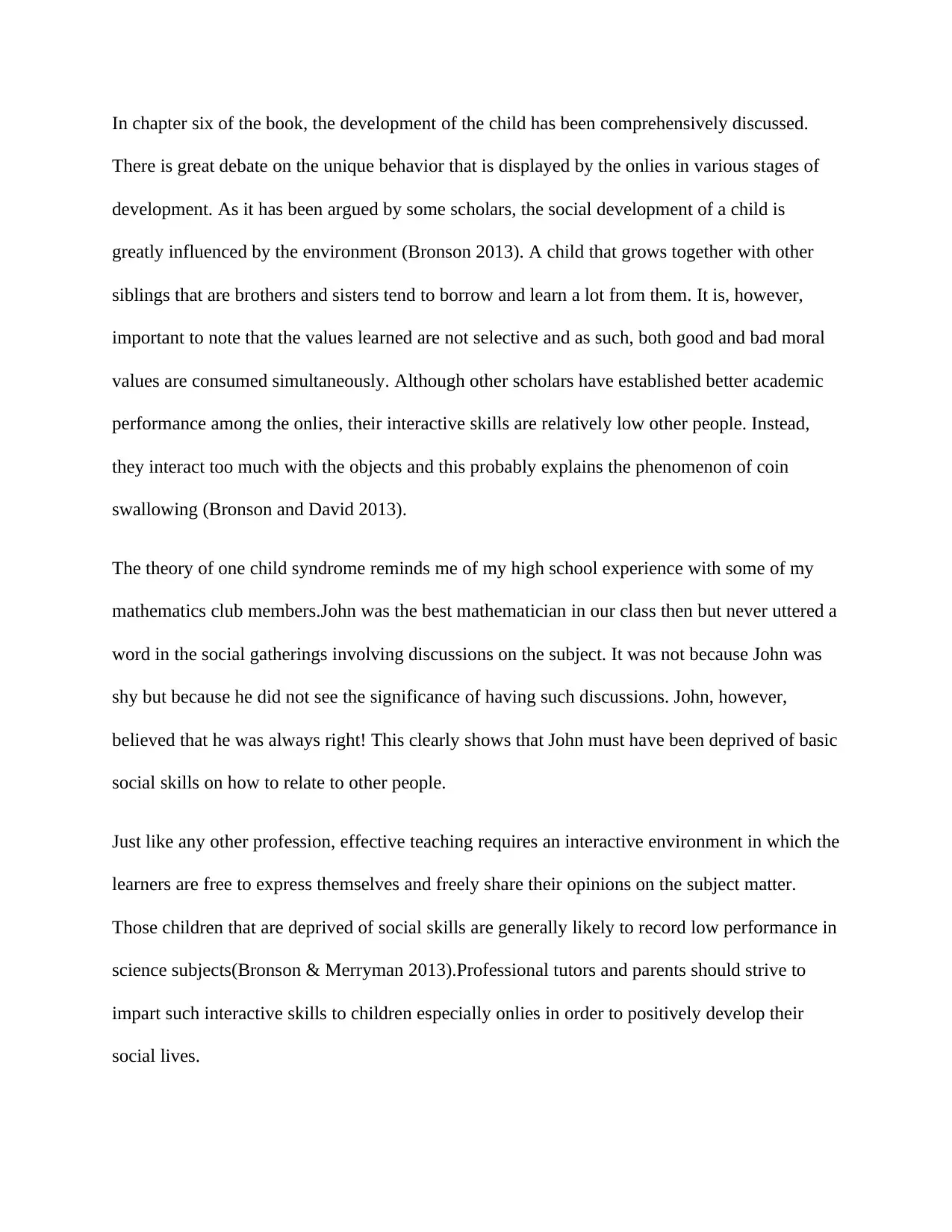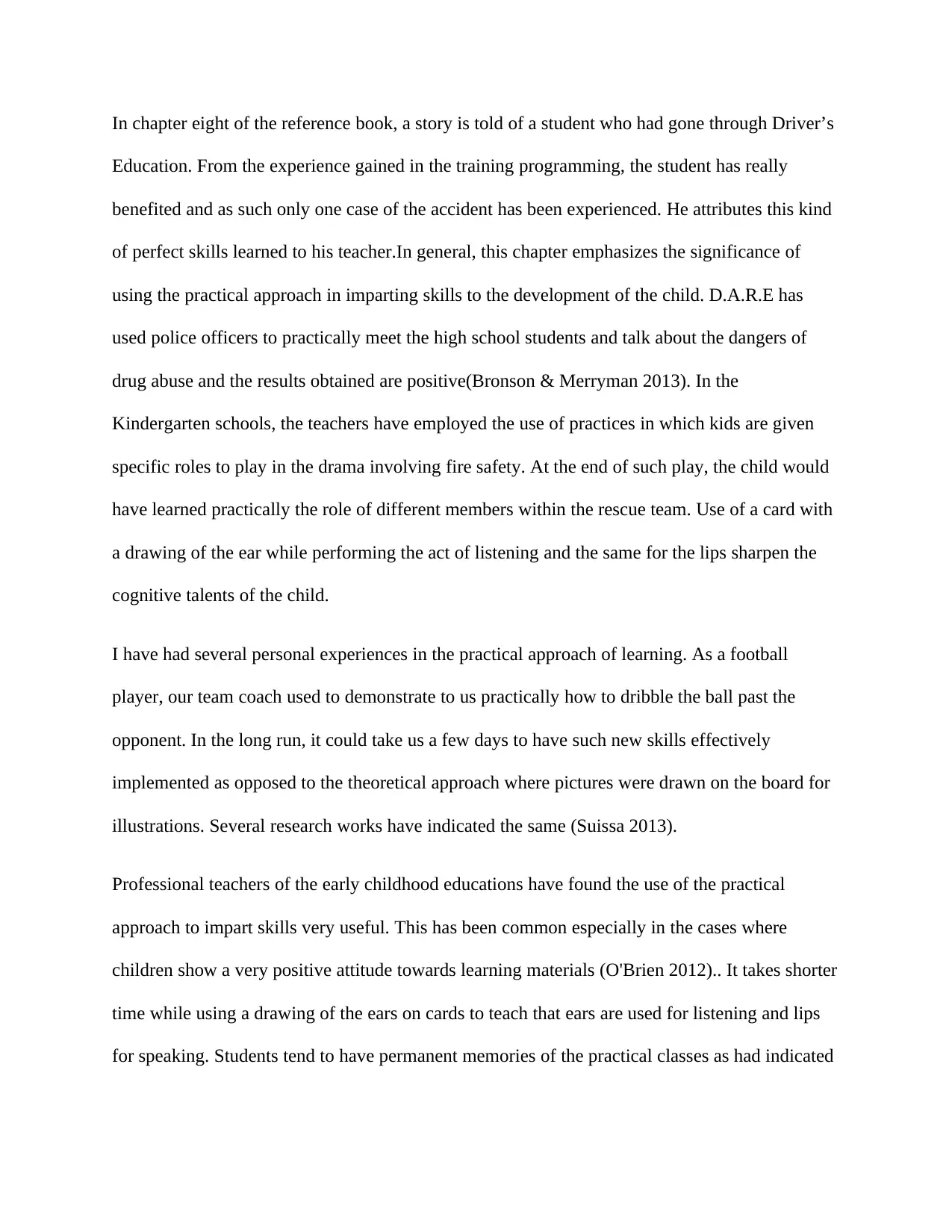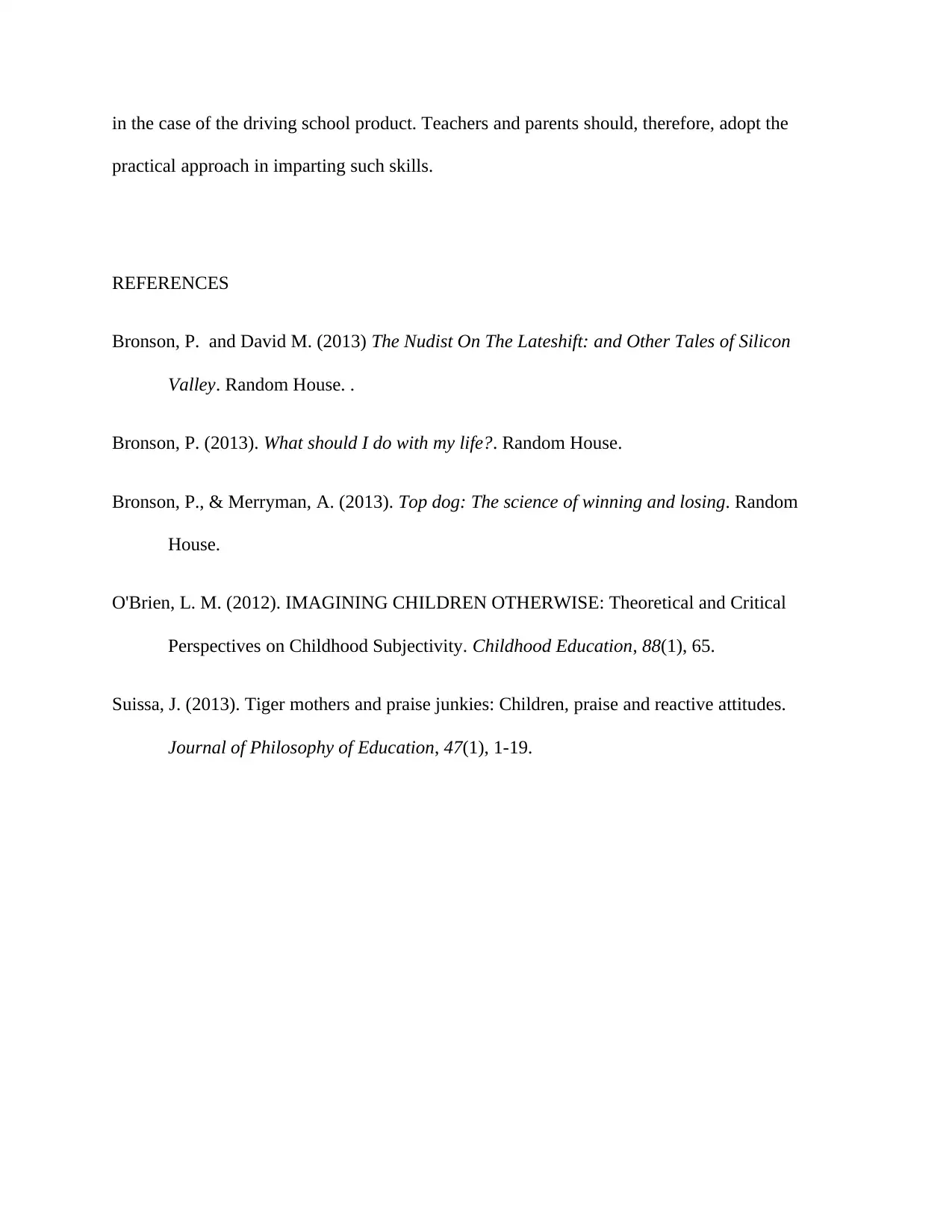Analysis of Child Development: Practical Learning and Skills
VerifiedAdded on 2023/05/31
|4
|886
|335
Homework Assignment
AI Summary
This assignment analyzes child development, focusing on the impact of environment and social interaction on children's behavior and learning. The analysis explores the one-child syndrome, highlighting the importance of social skills and interactive environments in education. It emphasizes the effectiveness of practical learning approaches, using examples from Driver's Education and early childhood education, and the application of these methods in teaching various skills. The assignment also underscores the need for educators and parents to foster interactive skills in children to enhance their overall development, particularly in science subjects. The provided references offer additional insights into the concepts discussed.

ELEMENTARY EDUCATION
[Author Name(s), First M. Last, Omit Titles and Degrees]
[Institutional Affiliation(s)]
[Author Name(s), First M. Last, Omit Titles and Degrees]
[Institutional Affiliation(s)]
Paraphrase This Document
Need a fresh take? Get an instant paraphrase of this document with our AI Paraphraser

In chapter six of the book, the development of the child has been comprehensively discussed.
There is great debate on the unique behavior that is displayed by the onlies in various stages of
development. As it has been argued by some scholars, the social development of a child is
greatly influenced by the environment (Bronson 2013). A child that grows together with other
siblings that are brothers and sisters tend to borrow and learn a lot from them. It is, however,
important to note that the values learned are not selective and as such, both good and bad moral
values are consumed simultaneously. Although other scholars have established better academic
performance among the onlies, their interactive skills are relatively low other people. Instead,
they interact too much with the objects and this probably explains the phenomenon of coin
swallowing (Bronson and David 2013).
The theory of one child syndrome reminds me of my high school experience with some of my
mathematics club members.John was the best mathematician in our class then but never uttered a
word in the social gatherings involving discussions on the subject. It was not because John was
shy but because he did not see the significance of having such discussions. John, however,
believed that he was always right! This clearly shows that John must have been deprived of basic
social skills on how to relate to other people.
Just like any other profession, effective teaching requires an interactive environment in which the
learners are free to express themselves and freely share their opinions on the subject matter.
Those children that are deprived of social skills are generally likely to record low performance in
science subjects(Bronson & Merryman 2013).Professional tutors and parents should strive to
impart such interactive skills to children especially onlies in order to positively develop their
social lives.
There is great debate on the unique behavior that is displayed by the onlies in various stages of
development. As it has been argued by some scholars, the social development of a child is
greatly influenced by the environment (Bronson 2013). A child that grows together with other
siblings that are brothers and sisters tend to borrow and learn a lot from them. It is, however,
important to note that the values learned are not selective and as such, both good and bad moral
values are consumed simultaneously. Although other scholars have established better academic
performance among the onlies, their interactive skills are relatively low other people. Instead,
they interact too much with the objects and this probably explains the phenomenon of coin
swallowing (Bronson and David 2013).
The theory of one child syndrome reminds me of my high school experience with some of my
mathematics club members.John was the best mathematician in our class then but never uttered a
word in the social gatherings involving discussions on the subject. It was not because John was
shy but because he did not see the significance of having such discussions. John, however,
believed that he was always right! This clearly shows that John must have been deprived of basic
social skills on how to relate to other people.
Just like any other profession, effective teaching requires an interactive environment in which the
learners are free to express themselves and freely share their opinions on the subject matter.
Those children that are deprived of social skills are generally likely to record low performance in
science subjects(Bronson & Merryman 2013).Professional tutors and parents should strive to
impart such interactive skills to children especially onlies in order to positively develop their
social lives.

In chapter eight of the reference book, a story is told of a student who had gone through Driver’s
Education. From the experience gained in the training programming, the student has really
benefited and as such only one case of the accident has been experienced. He attributes this kind
of perfect skills learned to his teacher.In general, this chapter emphasizes the significance of
using the practical approach in imparting skills to the development of the child. D.A.R.E has
used police officers to practically meet the high school students and talk about the dangers of
drug abuse and the results obtained are positive(Bronson & Merryman 2013). In the
Kindergarten schools, the teachers have employed the use of practices in which kids are given
specific roles to play in the drama involving fire safety. At the end of such play, the child would
have learned practically the role of different members within the rescue team. Use of a card with
a drawing of the ear while performing the act of listening and the same for the lips sharpen the
cognitive talents of the child.
I have had several personal experiences in the practical approach of learning. As a football
player, our team coach used to demonstrate to us practically how to dribble the ball past the
opponent. In the long run, it could take us a few days to have such new skills effectively
implemented as opposed to the theoretical approach where pictures were drawn on the board for
illustrations. Several research works have indicated the same (Suissa 2013).
Professional teachers of the early childhood educations have found the use of the practical
approach to impart skills very useful. This has been common especially in the cases where
children show a very positive attitude towards learning materials (O'Brien 2012).. It takes shorter
time while using a drawing of the ears on cards to teach that ears are used for listening and lips
for speaking. Students tend to have permanent memories of the practical classes as had indicated
Education. From the experience gained in the training programming, the student has really
benefited and as such only one case of the accident has been experienced. He attributes this kind
of perfect skills learned to his teacher.In general, this chapter emphasizes the significance of
using the practical approach in imparting skills to the development of the child. D.A.R.E has
used police officers to practically meet the high school students and talk about the dangers of
drug abuse and the results obtained are positive(Bronson & Merryman 2013). In the
Kindergarten schools, the teachers have employed the use of practices in which kids are given
specific roles to play in the drama involving fire safety. At the end of such play, the child would
have learned practically the role of different members within the rescue team. Use of a card with
a drawing of the ear while performing the act of listening and the same for the lips sharpen the
cognitive talents of the child.
I have had several personal experiences in the practical approach of learning. As a football
player, our team coach used to demonstrate to us practically how to dribble the ball past the
opponent. In the long run, it could take us a few days to have such new skills effectively
implemented as opposed to the theoretical approach where pictures were drawn on the board for
illustrations. Several research works have indicated the same (Suissa 2013).
Professional teachers of the early childhood educations have found the use of the practical
approach to impart skills very useful. This has been common especially in the cases where
children show a very positive attitude towards learning materials (O'Brien 2012).. It takes shorter
time while using a drawing of the ears on cards to teach that ears are used for listening and lips
for speaking. Students tend to have permanent memories of the practical classes as had indicated
⊘ This is a preview!⊘
Do you want full access?
Subscribe today to unlock all pages.

Trusted by 1+ million students worldwide

in the case of the driving school product. Teachers and parents should, therefore, adopt the
practical approach in imparting such skills.
REFERENCES
Bronson, P. and David M. (2013) The Nudist On The Lateshift: and Other Tales of Silicon
Valley. Random House. .
Bronson, P. (2013). What should I do with my life?. Random House.
Bronson, P., & Merryman, A. (2013). Top dog: The science of winning and losing. Random
House.
O'Brien, L. M. (2012). IMAGINING CHILDREN OTHERWISE: Theoretical and Critical
Perspectives on Childhood Subjectivity. Childhood Education, 88(1), 65.
Suissa, J. (2013). Tiger mothers and praise junkies: Children, praise and reactive attitudes.
Journal of Philosophy of Education, 47(1), 1-19.
practical approach in imparting such skills.
REFERENCES
Bronson, P. and David M. (2013) The Nudist On The Lateshift: and Other Tales of Silicon
Valley. Random House. .
Bronson, P. (2013). What should I do with my life?. Random House.
Bronson, P., & Merryman, A. (2013). Top dog: The science of winning and losing. Random
House.
O'Brien, L. M. (2012). IMAGINING CHILDREN OTHERWISE: Theoretical and Critical
Perspectives on Childhood Subjectivity. Childhood Education, 88(1), 65.
Suissa, J. (2013). Tiger mothers and praise junkies: Children, praise and reactive attitudes.
Journal of Philosophy of Education, 47(1), 1-19.
1 out of 4
Related Documents
Your All-in-One AI-Powered Toolkit for Academic Success.
+13062052269
info@desklib.com
Available 24*7 on WhatsApp / Email
![[object Object]](/_next/static/media/star-bottom.7253800d.svg)
Unlock your academic potential
Copyright © 2020–2025 A2Z Services. All Rights Reserved. Developed and managed by ZUCOL.





